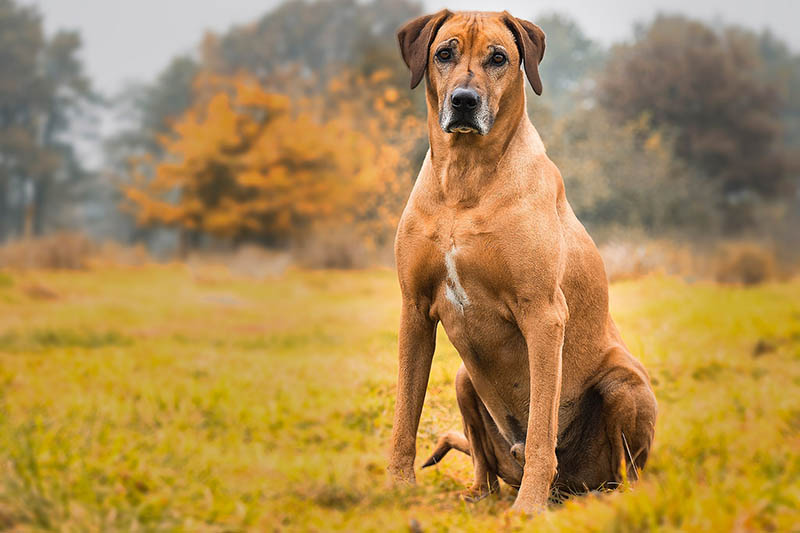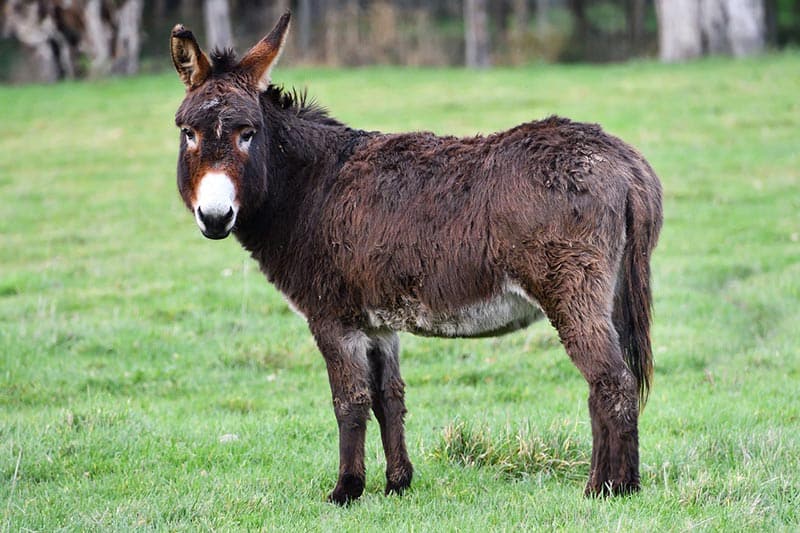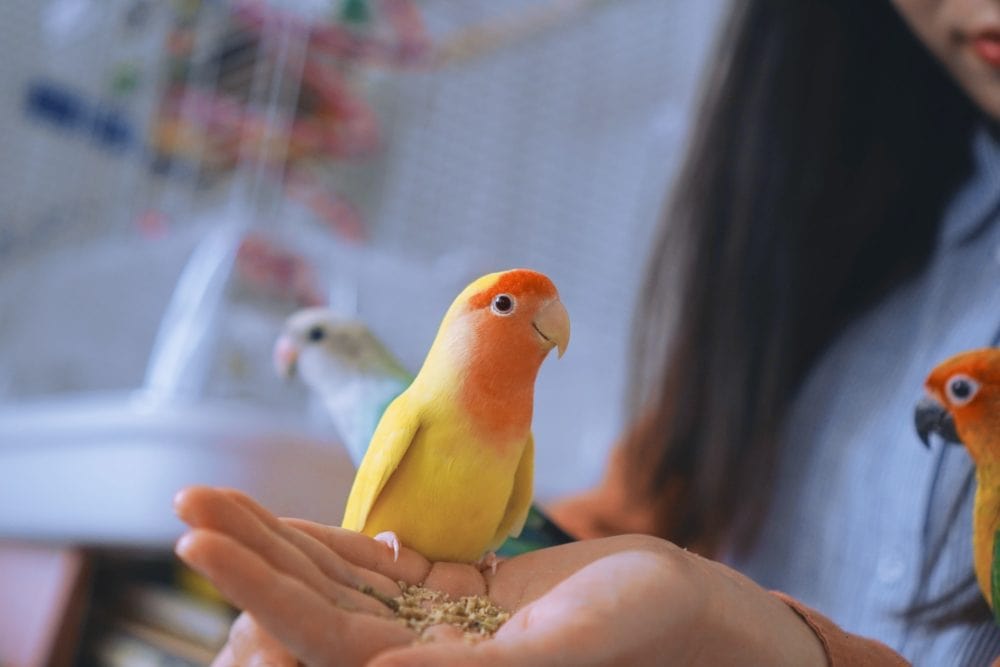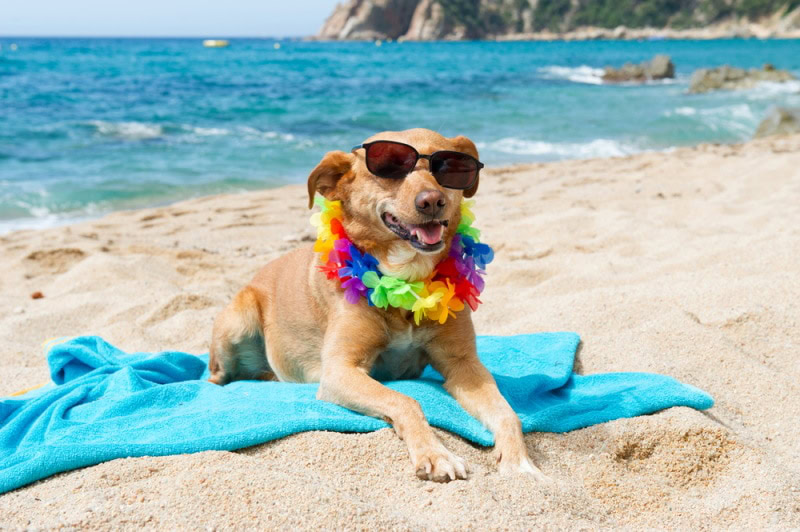VET APPROVED

The information is current and up-to-date in accordance with the latest veterinarian research.
Learn more »The defining ridge may be the most recognizable part of the Rhodesian Ridgeback, but it’s hardly the only trait that sets the breed apart. Rhodesian Ridgebacks are incomparably courageous and loyal. Boasting a stature and power that belies their sweet nature, they’ll surprise you with their lovability, grace, and family-friendly temperament.
And still, even after owning and enjoying the company of a Rhodesian Ridgeback, you’ll be amazed at how much more there is to learn about this storied breed. Find out what separates these remarkable hounds from the rest of the pack with our look at nine fascinating Rhodesian Ridgeback facts.

The 9 Rhodesian Ridgeback Facts
1. Rhodesian Ridgebacks Stem From Multiple Breeds
Rhodesian Ridgebacks came about when Europeans bred their dogs with the now-extinct breed of the indigenous Khoikhoi people. The Dutch settlers in South Africa, known as Boers, referred to the Khoikhoi as “Hottentots,” a term that is now considered offensive. This term was also sometimes used to describe their native dogs.
The ridge-backed dogs were valuable for their intrepid spirits and hunting acumen. As native animals, they had the added benefit of local disease and parasite resistance. Upon arriving in the area, the Boers (and later, the Brits) noted the Khoikhoi dog’s benefits.
In the late 19th century, a missionary called Charles Helm brought to Rhodesia two dogs from South Africa. When a well-known hunter, Cornelius van Rooyen. incorporated these two females and their offspring into his pack of lion dogs and realized their keenest senses, exceptional athleticism, and extreme devotion, he started working to make the foundation of the breed. These dogs boasted an all-around brilliance and were as dependable in the field working game as they were in defending the home and providing companionship.
2. Rhodesian Ridgebacks Were Originally Lion Hunters
There’s no metaphor for the Rhodesian Ridgeback’s nickname, the “Lion Hound.” The grasslands and savannahs of southern Africa presented numerous mortal threats to livestock and their owners. Chief among them were lions. As natives discovered that the ridged back within their dog populations indicated a certain level of courage and fortitude, they bred their dogs to help them hunt their most fearsome prey.
These dogs weren’t lion fighters, as many mistakenly believe. In a one-on-one battle, a Ridgeback, much less any other dog, wouldn’t stand a chance.
Instead, dogs worked in packs, relying on their cunning, agility, and poise to chase down and corner their prey. A trained dog would use its speed to evade its target, wearing the lion out and positioning it to give the hunter a clear kill shot.
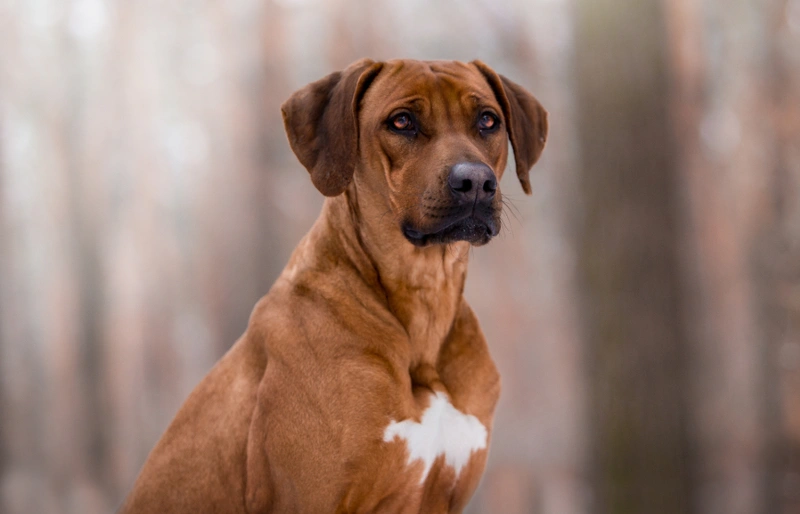
3. Rhodesian Ridgebacks Come in Only One Color
The Rhodesian Ridgeback comes in varying hues, yet they all fall under one category, wheaten. The coat can range from deep reds to pale gold, but wheaten is not a flat color. The short hairs have a variegated coloration, typically getting darker toward the tips.
Although wheaten is the only AKC-accepted color, several other unique hues and patterns exist. Brindle presents gorgeous stripes that look even crisper and more spectacular along the dog’s glossy coat. Ridgebacks may also appear in neutral variations, including black and tan, silver, and black.
4. Rhodesian Ridgebacks Are Excellent Coursing Dogs
The Rhodesian Ridgeback’s history as a hunting dog has allowed it to transition to an elite modern-day coursing dog. During the hunt, these dogs worked in small packs and used explosive bursts in coordinated attacks to barrel into and take down prey. Watching them give chase in full-bore sprints and rapid turns during a lure coursing event highlights their sighthound heritage.
Ridgebacks treat onlookers to a marvelous display, even if they are a hair smaller than their fast-paced peers. As a nimble breed, Rhodesian Ridgebacks can reach speeds of up to 30 mph!
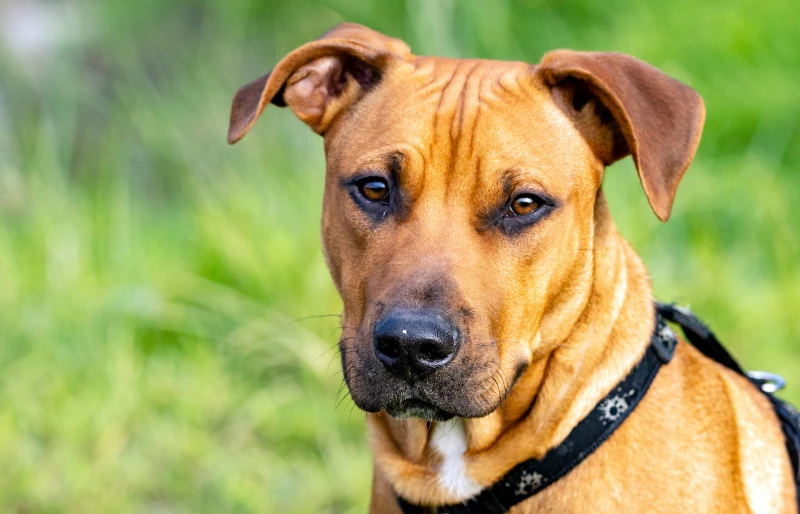
5. Rhodesian Ridgebacks Are a Multi-Purpose Breed
Coursing and cornering lions gave Rhodesian Ridgebacks their notoriety, but they had several jobs within their communities. Their role in lion-hunting was less common than their work as guard dogs and farm animals.
With such versatility, a rift eventually emerged in the breeding focus. Some bred dogs for sighthound work, and others desired protective Mastiff-type dogs for help around the home and farm. South African farmers often used Rhodesian Ridgebacks to guard their property and herd livestock.
As hunting dogs, Ridgebacks were the go-to lion specialists. But that wasn’t necessarily their primary purpose in the field. Lion-hunting often only occurred on an “as-needed” basis to deal with local threats.
Ridgebacks were far more versatile in everyday hunting. Alongside coursing and sniffing out game, they ably fulfilled gun dog duties. They were an indispensable aid in hunting everything from birds to antelopes to jackals.
6. There Is Some Debate Over the Ridgeback’s Classification
The AKC recognized the Rhodesian Ridgeback as a member of the Hound group in 1955. While few would argue the broad classification given the dog’s South African roots, deeper delineation draws some debate.
A proper Rhodesian Ridgeback is balanced, with little exaggeration in its form or movement. It is powerful and athletic yet graceful. Balance permeates its character, extending to its temperament and abilities. Labeling it as a specific type of hound has been challenging because the dog displays skills common to several dog types.
For most people, the Rhodesian Ridgeback is a sighthound. In particular, it needed excellent vision to track and confront lions, using its acute senses to steer clear of swiping claws. It displays incredible stamina and a powerful stride on the coursing run, similar to other sighthounds like the Greyhound or Borzoi.
Another argument frames the Ridgeback as a scent hound. The breed used their endurance and capable nose in Africa to locate game. But given the versatility between sight and scent, others label Rhodesian Ridgebacks as cur dogs that use multiple senses for hunting efficiency. Still more consider Ridgebacks as wagon dogs, showing just how well-rounded these dogs were as workers.
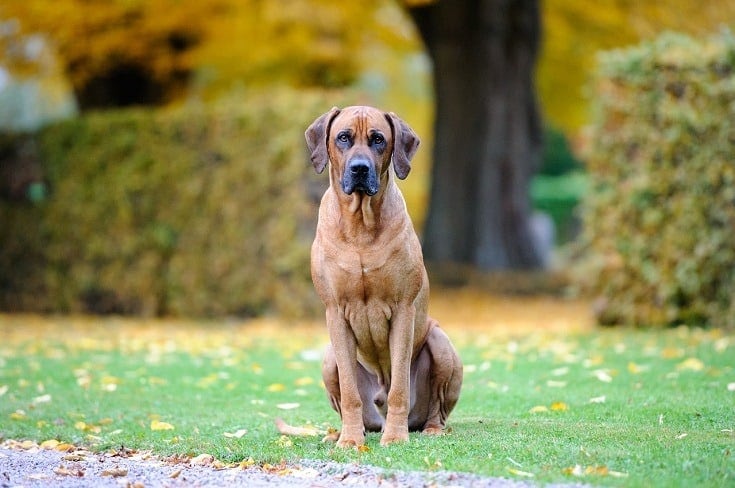
7. Rhodesians Are One of Three Breeds with Ridges
The Rhodesian is likely the first dog anyone imagines when thinking of the spinal ridge, but there are two other dogs with the mutation. The Phu Quoc Ridgeback is a muscular hunting dog hailing from Vietnam. It has no official standard as a rare breed living on Phu Quoc Island. With a temperament like the Rhodesian Ridgeback’s, it is easy to train and highly intelligent.
The Thai Ridgeback, a close relative to the Phu Quoc Ridgeback, is another intelligent, hardy, and extraordinarily athletic breed. Like the Phu Quoc breed, the Thai Ridgeback was a versatile worker and companion, helping owners pull carts, defend the home, and hunt pests.
8. The Ridge Is Linked to a Developmental Defect
A dermoid sinus is a tubular defect in the skin along the spine and neck. The small hole (or holes) appears when the neural tube doesn’t close off entirely as the young fetus grows. The thread-like openings are challenging to spot but can be felt and sometimes seen at the center of a swirl of hair.
Signs of DS may be mild, such as light discharge, or non-existent. Complications arise when an abscess develops from keratin, bacteria, and other agents filling the opening. Severe neurological disorders and inflammation (e.g., meningitis) may result, especially if the sinus reaches the spinal cord.
Euthanasia is unnecessary, as DS is treatable through surgery, but dogs with defective genetics should not be part of a breeding program. With up to 20% of the population having a DS, Rhodesian Ridgebacks are particularly susceptible.
Unfortunately for enthusiasts, research shows that the autosomal dominant gene causing ridged fur may also have a link to the disorder. Many feel ridgeless dogs should be prioritized in addressing the breed’s welfare. But as the ridge is a standard focal point, the idea hasn’t met broad acceptance from breeders.
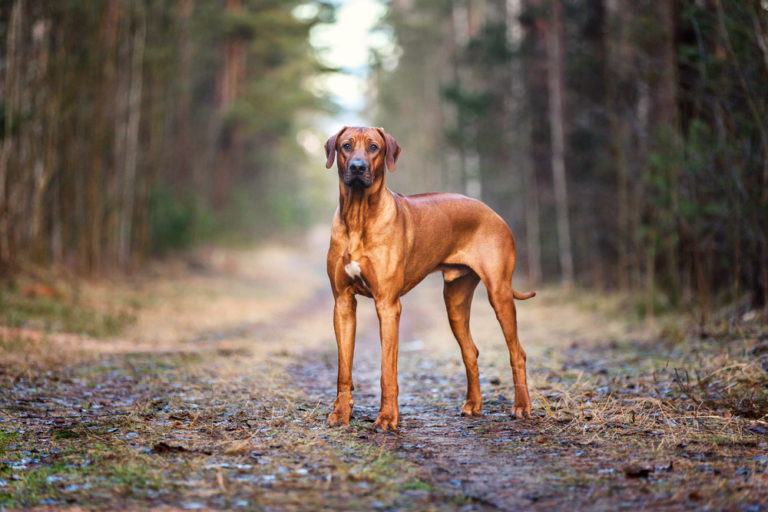
9. Rhodesian Ridgebacks Are More Difficult to Insure
Few dog breeds (if any) can claim the loyalty Rhodesian Ridgebacks possess. They are exceptionally devoted to their owners and family. Stories of dogs sacrificing themselves without hesitation to save their handlers in dangerous African hunts weren’t uncommon. They’re guardians at heart with a prey drive that breeders heavily encouraged in their early years.
While modern Ridgebacks are much more subdued than their African ancestors, they remain highly independent and responsive to their owners’ cues when interacting with strangers. Proper training and socialization are essential to ensure they develop into well-mannered companions. Without clear leadership and consistent training, Ridgebacks can become overly protective or stubborn, which may lead to problematic behaviors. Their natural drive to chase, guard, and assert dominance can make them challenging for inexperienced owners.
Due to their protective instincts, some homeowners’ insurance companies classify Rhodesian Ridgebacks as a high-risk breed. Insurers may view their strong-willed nature and guarding tendencies as a potential liability, particularly if they have not received adequate training and socialization from an early age.

Summary
Rhodesian Ridgebacks are remarkable in many ways. They’re incredibly intelligent, impressively athletic, and loyal to a fault. Training takes confidence, knowledge, and dedication to control their strong will. But with the proper upbringing, they’ll only supply endless affection and comfort. As these Rhodesian Ridgeback facts prove, each day presents an opportunity to learn something new about these marvelous dogs.
Featured Image Credit: du_weist_schon_wer, Pixabay
Contents
- The 9 Rhodesian Ridgeback Facts
- 1. Rhodesian Ridgebacks Stem From Multiple Breeds
- 2. Rhodesian Ridgebacks Were Originally Lion Hunters
- 3. Rhodesian Ridgebacks Come in Only One Color
- 4. Rhodesian Ridgebacks Are Excellent Coursing Dogs
- 5. Rhodesian Ridgebacks Are a Multi-Purpose Breed
- 6. There Is Some Debate Over the Ridgeback’s Classification
- 7. Rhodesians Are One of Three Breeds with Ridges
- 8. The Ridge Is Linked to a Developmental Defect
- 9. Rhodesian Ridgebacks Are More Difficult to Insure
- Summary
